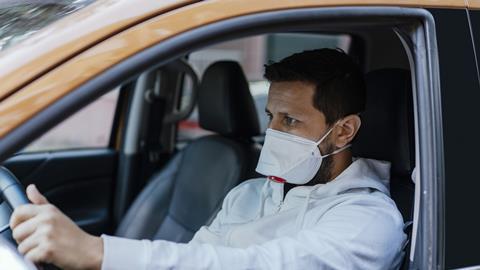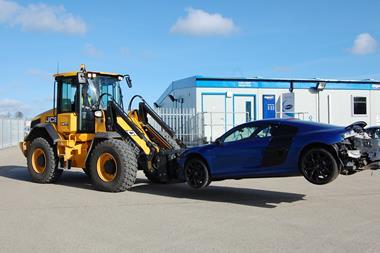The coronavirus pandemic has presented a number of challenges for the insurance industry, but the motor market is uniquely placed in that tighter lockdown conditions may actually result in improved claims experiences for insurers
The coronavirus outbreak has seen the world descend into chaos as streets fall quiet, businesses close and global markets grind to a halt.
The global pandemic that first hit headlines back in January 2020 is now prevalent in more than 200 countries worldwide, with more than 1.3 million confirmed cases and almost 75,000 related deaths.
For many the worst is still to come, but in its own little microcosm, motor insurance is bucking the trend as lockdowns force people to stay in their homes with cars parked firmly on the driveway.
This lack of cars making it onto the road has resulted in motor claims volumes falling away, and KPMG insurance director James Hillon says his firm has been hearing of motor claims being reduced by as much as a half as a result of the lockdown in the UK.
“There is an expectation of a much reduced claims frequency because of the marked reduction in journeys being made, and we are hearing numbers in the order of a 50% reduction in claims frequency,” he says. “But, anecdotally, we are also hearing that the impact on the cost of claims could be quite variable, and more difficult to predict, than claims frequency.”
Hillon says that this variability is driven by a number of different factors, including an increase in repair costs as a result of the enormous pressure being placed on the supply chain, both from a labour and parts standpoint, as well as the changing nature of car journeys and its effect on personal injury claims following a motor accident.
“When it comes to injury claims, there are a couple of factors at play, one is in terms of there being less occupants in the vehicles when they are on the roads, so less claimants per claim, but it is also less likely that accidents will involve children, which inevitably and sadly are the most expensive types of claims for insurers,” he says.
And EY executive director Tony Sault says claims severity is also expected to fall.
“We would expect less severe accidents, because most people won’t be travelling long distances at speed on motorways, which is the situation that creates the most horrendous accidents,” he says. “And there are also less pedestrians walking around and less speeding, so the severity of accidents should decrease.”
Pricing Conundrum
Despite the complicated nature of the situation, Hillon says that KPMG is predicting an upturn for UK motor insurers, at least in the short-term, although that presents its own problems for many in the industry.
“Our view would be that we are likely to see a material improvement in the profitability of motor insurers as a result of the lower claims,” he says. “That gives rise to the question of price and potentially lower premiums, as well as how motor insurers would deal with that increased profitability from a reputational standpoint at a time when, clearly and rightly, the government is calling on all sectors to support the challenges that are facing the country.”
This makes any pricing decisions particularly hard to navigate.
“Part of the pricing is based on previous claims experience, and part is based on future expected claims experience, and that is the great unknown,” EY’s Sault says. “Claims volumes and costs are going to be down for the next few weeks at least, but nobody knows how long that will go on for, so how can you price for that?
“Insurers will want to recognise the need that everyone is tightening their belts, looking at their household budgets and questioning the need for insurance across the classes, and insurers will have to tread a very careful line to price accordingly and maintain customers.”
Hillon says this will be easier for those businesses that have set their business up to succeed in the digital era.
“Pricing is an opportunity that some may see as a way to grow their business at this time, but people will be very mindful of the operational stresses that that might cause,” Hillon says. “People are struggling to run call centre operations in particular, so growing your business by reducing premium rates puts you under greater stress, and therefore might not be the right thing to do from a customer perspective.
“Insurers that are more digitally enabled for end-to-end services, might be presented with that opportunity, but others may be mindful of the risk associated with growing their business right now.”
This has led to some motor insurance providers taking some novel approaches to promoting their policies, with telematics specialist InsureTheBox selling black box policies without the box being fitted, mainly because they are unable to fit them during the lockdown, but also because they know they can sell the policies without too much risk of the policyholder actually driving the vehicle.
Fellow telematics provider Carrot, meanwhile, is offering double rewards, usually reserved for the safest drivers, for any policyholder that doesn’t take their vehicle out on the road at all.
But are things as rosy as they seem for motor insurers?
Willis Towers Watson head of claims consulting Tom Helm says the drop off in vehicle miles, and hence claims, that insurers are experiencing at the moment may not be all that long lasting, and could even become reversed once the lockdown is lifted.
“There are certainly less cars on the road at the moment, which over the short to medium-term will mean less accidents,” he says. “But as things get switched back on, we could see a surge of people travelling because they want to go out and leisure but can’t travel abroad as much, so there will be a lot more people going on staycations.”
Helm adds that current claims levels could even be artificially deflated because of policyholders being unable to fully inform their insurers of any accidents they have had during the lockdown.
“There will be a longer tail for insurers to deal with than what they are used to,” Helm says. “People that had an injury as a result of an accident, for example, aren’t necessarily able to get all the information because people aren’t able to be examined by medical experts, and the courts aren’t open for claims to be processed.
“So that flow of information is stopping for insurers, so they might not necessarily have the details of a person being injured, or if they are off work as a result of an injury, because that claim is stuck sitting on a lawyers desk.”
This, ultimately, could lead to claims rising to a higher level than what insurers are used to once the lockdown is lifted.
Claims Inflation Returns
Insurers will also have to be aware of further increases in claims inflation, something that has already dogged the industry for a number of years and will be exacerbated by the additional stress being placed in the insurer supply chain.
ThingCo founder and chief executive Mike Brockman says the issue here is that, with no one crashing, no one is needing repairs.
“While no one driving is good for insurers, it is not good for those operating in the claims management and repair chain,” he says. “There are a lot of people struggling in that claims space, and how that pans out once all this is over is not clear.
“Supply chains will definitely be affected once all this goes back to normality, and insurers could struggle with capacity once that arrives. While motor insurers may think they are sitting pretty at the moment, they might have to put their hand in their pockets to help out some of their suppliers one everything gets back to normal.”
Hillon agrees.
“There will be long-term impacts on claims inflation,” he says. “The insurance industry is incredibly interconnected, and is characterised by a very long supply chain. Inevitably we are likely to see some stress on layers within that supply chain in the short to medium-term, and if that results in some of those businesses failing, then that causes insurers challenges in terms of replacing capacity and inflationary pressure if they can’t.”
Helm says even those repair networks that are still operating will be facing additional pressures, and that this could result in more costly write-offs as insurers struggle to get vehicles repaired.
“The supply chain has been gradually closing down, and one of the key issues with that is a lack of supply of parts because of the stopping of production and distribution,” he says. “So even if you are open if you can’t get the parts then you can’t do the repairs anyway.
“That will be a growing challenge for insurers [the longer the lockdown goes on], and they can certainly expect to settle a lot more claims on a total loss basis, simply because there won’t be the parts available to repair vehicles.”
But while these pressures may not persist for too long beyond the end of the lockdown, whenever that may come, it could be that coronavirus has changed the landscape of the UK motor insurance industry for good.
“Once everything returns to normal, we could see a lot more people working from home and insurers will have to think about what that does to the risk pool and how they adapt to the changed nature of risk in a new normal,” KPMG’s Hillon says. “The future of the motor market will be different to the current, because of these changes in behaviour, and this could continue over the long-term.”
Read more…Esure back in profit but underwriting struggles continue
Not subscribed? Become a subscriber and access our premium content

Hosted by comedian and actor Tom Allen, 34 Gold, 23 Silver and 22 Bronze awards were handed out across an amazing 34 categories recognising brilliance and innovation right across the breadth of UK general insurance.





















































No comments yet